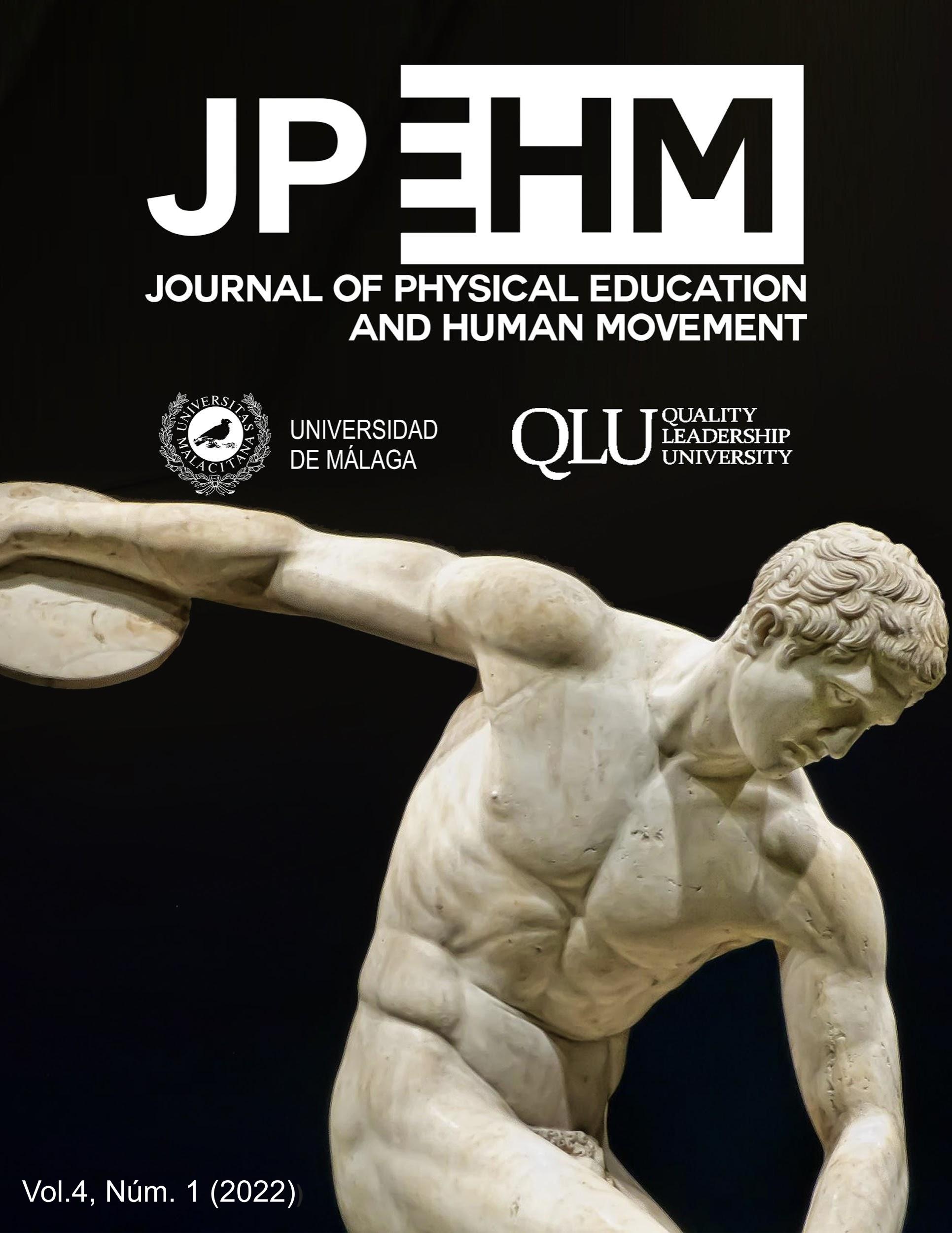Differences in physical-coordinative capacities in children from 6 to 12 years old
DOI:
https://doi.org/10.24310/JPEHMjpehmjpehm.v4i113391Keywords:
Coordination, speed, flexibility, football, sedentaryAbstract
Sports practice has a positive influence on physical and coordination maturity in childhood. This is a descriptive study and its purpose was to assess the differences in coordination skills, speed and flexibility, between children participating in extracurricular sports activities and a control group. 146 schoolchildren between 6 and 12 years old (92 boys and 54 girls) participated, 68 who practiced athletics, 49 soccer and 29 who did not perform any extracurricular activity. Three different tests were applied whose main objective was to determine the significant differences in the levels of visual-motor and general coordination (Test 3JS), speed-coordination (Test shuttle run 4x10) and extensibility of the hamstring muscles (Test Sit and Reach). Data are reported as mean and standard deviation. A descriptive analysis and analysis of variance (ANOVA) have been performed to examine the differences between the three groups (athletics, football and control group). The results of this analysis point to the existence of significant differences between the groups that perform extracurricular sports with respect to the control group. The soccer group is the one that shows the highest coordination index and the one that registers the lowest scores in flexibility. The athletics group is the one that shows the best index in flexibility and in task 5 (Slalom race, General dynamic coordination) of the 3JS Test. The control group obtained the lowest results in the different tests with respect to the schoolchildren who participated in extracurricular sports, except in the levels of flexibility, which are slightly better than the soccer group.
Downloads
Metrics
References
Arregui Eraña, J.A. & Martínez de Haro, V. (2001). Estado actual de las investigaciones sobre la flexibilidad en la adolescencia. Revista Internacional de Medicina y Ciencias de la Actividad Física y el Deporte vol. 1 (2) p. 127-135.
Caro Muñoz, O. (2012). La musculatura isquiotibial en el fútbol: la lesión del bíceps femoral. Revista Internacional de Deportes Colectivos, (11), 18-44.
Castro-Piñero, J., Chillón, P., Ortega, F. B., Montesinos, J. L., Sjöström, M., & Ruiz, J. R. (2009). Criterion-related validity of sit-and-reach and modified sit-and-reach test for estimating hamstring flexibility in children and adolescents aged 6–17 years. International journal of sports medicine, 30(09), 658-662.
Cenizo-Benjumea, J. M., Revelo-Afonso, J., Ferreras-Mencía, S., & Gálvez-González, J. (2019). Diferencias de Género en el Desarrollo de la Coordinación Motriz en Niños de 6 a 11 Años.
Cenizo Benjumea, J. M., Ravelo Afonso, J., Morilla Pineda, S., & Fernández Truan, J. C. (2017). Motor Coordination Test 3JS: Assessing and analyzing its implementation RETOS. Nuevas Tendencias en Educación Física, Deporte y Recreación, 32, 189-193.
Fernández Rodríguez, E., Merino Marbán, R., Romero Ramos, O., Mayorga Vega, D., & Burgueño Mengibar, R. (2011). Deportes extraescolares y flexibilidad en alumnos de primaria. TRANCES. Transmisión del Conocimiento Educativo y de la Salud, (6), 695-712.
López-Miñarro, P. Á., Ibarra, A. G., & García, P. L. R. (2010). Comparación entre diferentes test lineales de medición de la extensibilidad isquiosural. Apunts Educación Física y Deportes, (99), 56-64.
Ortega, F. B., Artero, E. G., Ruiz, J. R., España-Romero, V., Jiménez-Pavón, D., Vicente-Rodríguez, G., Moreno, L. A., Manios, Y., Beghin, L., Ottevaere, C., Ciarapica, D., Sarri, K., Dietrich, S., Blair, S. N., Kersting, M., Molnar, D., Gonzalez-Gross, M., Gutierrez, A., Sjostrom, M., & Castillo, M. J. (2011). Physical fitness levels among European adolescents: the HELENA study. British journal of sports medicine, 45(1), 20-29.
Ruíz, J. R., España Romero, V., Castro Piñero, J., Artero, E. G., Ortega, F. B., Cuenca García, M., Jiménez Pavón D., Chillón P., Girela Rejón M.J., Mora J., Gutiérrez A., Suni J., Sjöstrom M, & Castillo, M. J. (2011). Batería ALPHA-Fitness: test de campo para la evaluación de la condición física relacionada con la salud en niños y adolescentes. Nutrición Hospitalaria, 26(6), 1210-1214.
Salas Guevara, M. F., & Giraldo Toro, A. F. (2018). Efecto de un programa de entrenamiento propioceptivo sobre las capacidades coordinativas en fútbol femenino de formación de 10-15 años del Club Besser.
Torres, M. A. (2005). Enciclopedia de la Educación Física y el Deporte. Barcelona: Ediciones del Serbal.
Turrado Hernán, R. (2017). Factores que afectan a la flexibilidad de los alumnos de Educación Primaria: análisis de un centro educativo. (Trabajo de fin de grado). Universidad de Valladolid. España.
Vicente-Rodríguez, G., Rey-López, J. P., Ruíz, J.R., Jiménez-Pavón, D., Bergman, P., Ciarapica, D., Heredia, J.M., Molnar, D., Gutierrez, A., Moreno, L.A., & Ortega, F.B. (2011). Interrater reliability and time measurement validity of speed–agility field tests in adolescents. The Journal of Strength & Conditioning Research, 25(7), 2059-2063.
Zuil Escobar, J. C., Rodríguez Fernández, A.L., Martínez Cepa, C.B., & López Andrino, J. (2004). Estudio de la relación entre la práctica del fútbol y el acortamiento muscular. Fisioterapia, 26(6), 340-348.
Downloads
Published
How to Cite
Issue
Section
License
Aquellos autores/as que tengan publicaciones con esta revista, aceptan los términos siguientes:
- Los autores/as conservarán sus derechos de autor y garantizarán a la revista el derecho de primera publicación de su obra, el cuál estará simultáneamente sujeto a la Licencia de reconocimiento de Creative Commons que permite a terceros compartir la obra siempre que se indique su autor y su primera publicación esta revista.
- Los autores/as podrán adoptar otros acuerdos de licencia no exclusiva de distribución de la versión de la obra publicada (p. ej.: depositarla en un archivo telemático institucional o publicarla en un volumen monográfico) siempre que se indique la publicación inicial en esta revista.
- Se permite y recomienda a los autores/as difundir su obra a través de Internet (p. ej.: en archivos telemáticos institucionales o en su página web) antes y durante el proceso de envío, lo cual puede producir intercambios interesantes y aumentar las citas de la obra publicada. (Véase El efecto del acceso abierto).







15.png)
